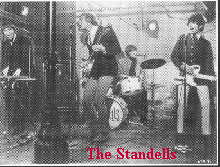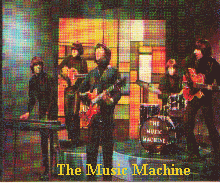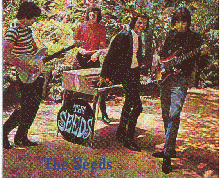![]() History
History![]()
I'd say this is a perfect introduction to the garagedom.I've taken it from the All Music Guide site and the author is Richie Unterberger who wrote two critically acclaimed books "The Unknown Legends of Rock ' n' Roll" and "Urban Spacemen & Wayfaring Strangers: Overlooked Innovators and Eccentric Visionaries of 60s Rock ".He's got a personal homepage too ( http://www.richieunterberger.com/)
Garage Rock by Richie Unterberger
For those who prize adolescent, primitive energy as one of rock &
roll's best features, the garage rock bands of the '60s rank at
or
near the top of the rock & roll pyramid. Ignored or even scorned
by critics in its heyday, garage rock proved an influential
inspiration for the punk rock explosion of the '70s, and
experienced a renaissance of sorts in the '80s,
among the rock underground and collector community if nowhere else.
Largely a North American phenomenon, the garage band movement began
in the wake of the British Invasion in 1964. There were already
plenty of young, White rock groups throughout the U.S., but they
were usually found playing instrumental (sometimes surf) rock or
heavily R&B-influenced "frat rock," and largely
unconcerned with
writing their own songs or making individualistic, rebellious
statements. The Beatles, Rolling Stones, Kinks, Animals and
others changed that overnight. Caught off-guard by this
unexpected onslaught, teenage groups put the focus on
loud electric guitars and grew their hair long in attempts to emulate their heroes.
What emerged was a distinctly cruder and more adolescent variation
on the British Invasion sound (which itself had been largely
inspired by American rock and R&B in the first place). It is not
accurate to say that the garage groups matched the talents of their
British idols, or of American outfits like the Byrds; they were
usually considerably younger and less sophisticated, and lacked the
songwriting skills or instrumental finesse of the era's major
groups. By way of compensation, perhaps, they placed a
premium on sheer outrageousness: over-the-top vocal
screams and sneers fought it out with loud guitars that
almost always had a fuzztone attached.Garage bands
were so named after the habitual practice space of the
musicians, which were overwhelmingly White, suburban, and teenaged.
While scattered 1964 recordings by groups like the Gestures and the
Barbarians served as early blueprints for the sound, it didn't
blanket the country properly until 1965, when virtually every major
city (and many minor ones) became home to dozens of new guitar
groups hungering for a piece of the action — which meant parties,
girls and, of course, records.
These records were usually pressed on tiny local labels, and usually
only heard within a 50-100 mile radius (if they were heard on local
radio at all). Occasionally they were picked up for nationwide
distribution by a larger company; more occasionally still, they
became bonafide national hits. The Shadows of Knight, The Count Five
the 13th Floor Elevators, The Standells, The Seeds, ? & The
Mysterians, and the Gentrys were among the lucky few who hit
this jackpot, although their time in the spotlight was
brief.An enormous amount of records were released by
garage bands in the '60s, particularly between 1965 and
1967.California and Texas were probably home to more of these bands per capita
than any other state, but the number of groups that recorded, let alone played,
was staggering. Detroit, Boston, Chicago, Minneapolis, Seattle,
Pittsburgh, Cleveland, Phoenix; they all were home to large local
scenes supporting several dozens of bands, much in the manner of
today's alternative rock and punk communities.
There are a great many generic garage band recordings: fuzzy
variations of the "Satisfaction" or "You Really Got Me" riffs,
simplistic lyrics about cheating girlfriends, inept guitar solos and
cheesy organ riffs. There are also a great many great garage
band
records by bands that combined their energy with sharp
songwriting skills, compelling hooks, or sheer unpredictable
mania.
The Texas bands favored galloping rhythms with bigger-than-life
fuzztones; the California bands often copped folk-rock and
psychedelic licks from their own local heroes; Midwest groups
sometimes drew upon trends in soul music; New England groups were
more prone to use Zombies-like keyboards and melodies; Cleveland
acts showed a strong affinity for Merseybeat and British power-pop.
But the bands from these far-flung territories had a lot more in
common than not; all of them kept abreast of the latest trends in
British rock, folk-rock, and psychedelic music.
A number of factors conspired to slow the momentum of the garage
phenomenon around 1967 and 1968. Facing college, lack of national
success and, worst of all, the military draft, many of the bands
simply didn't stay together for very long. Increasingly homogenous
national radio airplay and distribution meant less of a chance for
regional labels to succeed or get their records played, and hence
less opportunities for local talent to enter the studio. And the
fact was, a lot of the garage bands were outgrowing the pop/rock
of
the first wave of the British Invasion, and moving — as their
inspirations were — towards more progressive and psychedelic
sounds,with lyrics that, for better or worse, addressed more
mature concerns than picking up girls and adolescent
rebellion.
Almost immediately forgotten by rock historians, garage music
began its comeback when future Patti Smith Group guitarist Lenny Kaye
compiled the original Nuggets album in 1972. This double set
featured the most popular garage band recordings by the likes of the
Standells, Seeds, Chocolate Watch Band and others; Kaye helped coin
the term "punk rock" in his liner notes, in reference to bands such
as these that celebrated rock & roll at its most primal and
unself-conscious. Adding a measure of contemporary lyrical content
and attitude, bands like the Sex Pistols would embellish this
prototype and give birth to modern punk rock a few years later.
The Pebbles series of the late '70s took the Nuggets approach
several steps further, unearthing even rarer and rawer garage
band recordings from across the nation. Eventually
numbering dozens of volumes, Pebbles in turn kicked off a
deluge of '60s garage bandreissues and compilations; often
great, sometimes awful, these numbered in the hundreds
by the late '80s. Contemporary groups like
the Fuzztones the Pandoras, Thee Fourgiven and dozens of others
played garage revival music in the 1980s, though in truth they never
approached the authentic qualities of the best of the '60s garage,
and never made a significant impact on either the mainstream or
underground rock scenes.
The reissues introduced young and old listeners to scores of fine
bands, ironically giving them their greatest international exposure
decades after they broke up. Some, like the Remains or the Music
Machine were arguably too talented and innovative to be lumped
in
with the garage crowd in the first place. Others, like Zakary
Thaks, the Chocolate Watch Band and the Rising Storm
personified teenage rock & roll at its most enjoyable. All of the
above-mentioned groups — and quite a few others —
were nearly as good as the more accomplished
and more famous British and American hitmaking bands of
the era, and deserve belated recognition as first-rate '60s rock & rollers.
Home - Intro - Bands - Compilations - Sound Clips - Links